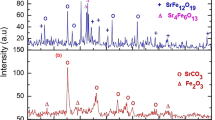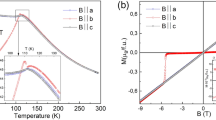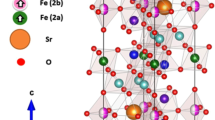Abstract
THE ferromagnetism of cassiterite, a widely occurring mineral consisting essentially of stannic oxide (SnO2), is commonly thought to be due to the small quantities of iron impurity present (less than 1 per cent by weight)1–3. We present here Mössbauer spectra from several samples of cassiterite, taken from widely different geographic locations, which show that either Fe2+ or Fe3+ can occur in dark magnetic cassiterites, contrary to inference from previous observations2,4. Further, by measuring 57Fe Mössbauer absorption as a function of temperature and magnetic field, we have deduced that the magnetic impurity in cassiterite occurs as a superparamagnetic precipitate in a wide range of particle sizes, down to spheres of a few tens of Ångstroms diameter. Finely divided particles in iron–manganese nodules have recently been found to behave in a similar way5.
This is a preview of subscription content, access via your institution
Access options
Subscribe to this journal
Receive 51 print issues and online access
$199.00 per year
only $3.90 per issue
Buy this article
- Purchase on Springer Link
- Instant access to full article PDF
Prices may be subject to local taxes which are calculated during checkout
Similar content being viewed by others
References
Hanuš, V., and Krs, M., Nature, 208, 675 (1965).
Grubb, P. L. C., and Hannaford, P., Nature, 209, 677 (1966).
Banerjee, S. K., J. Geophys. Res., 74, No. 12 (in the press).
Grubb, P. L. C., and Hannaford, P., Mineralium Deposita, 2, 148 (1966).
Johnson, C. E., and Glasby, G. P., Nature, 222, 376 (1969).
Cranshaw, T. E., Nucl. Instrum. Methods, 30, 101 (1964).
Cassedanne, Jeanine, Ann. Acad. Brazil Cienc., 38, 265 (1966).
Jacobs, I. S., and Bean, C. P., Magnetism, 3 (1963).
Kündig, W., et al., Phys. Rev., 142, 327 (1966).
Author information
Authors and Affiliations
Rights and permissions
About this article
Cite this article
BANERJEE, S., JOHNSON, C. & KRS, M. Mossbauer Study to find the Origin of Weak Ferromagnetism in Cassiterite. Nature 225, 173–175 (1970). https://doi.org/10.1038/225173a0
Received:
Revised:
Issue Date:
DOI: https://doi.org/10.1038/225173a0
Comments
By submitting a comment you agree to abide by our Terms and Community Guidelines. If you find something abusive or that does not comply with our terms or guidelines please flag it as inappropriate.



